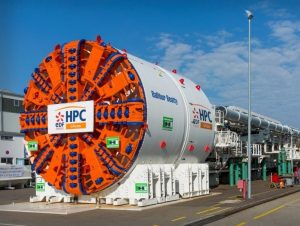
Emmeline pushes ahead under the Bristol Channel
The site’s second tunnel boring machine (TBM), Emmeline, has reached full bore mode as she excavates an outfall tunnel under the Bristol Channel. Pushing ahead at an average speed of 19m per day to create the 7m tunnel, Emmeline is operating about 40m beneath the seabed. The tunnel will be used to take cooling water back out to sea. The outfall will be 1,900m long and is similar to the work already carried out on intake tunnel one, which TBM Mary completed at the end of 2020.
Tunnel ‘heads’ completed
The final concrete has been poured at Avonmouth to complete the six super-heavy components known as heads that will form a massive part of the water-cooling system at HPC. The heads will eventually cap the tunnels currently being bored under the Bristol Channel. Their completion marks months of work from the Balfour Beatty, EDF and Kilnbridge teams. Each of the four intake heads weighs in at 4,650 tonnes, with 775 tonnes of reinforcement and 125,000 individual reinforcing bars. The two outfall heads weigh in at 3,500 tonnes each, with 250 tonnes of reinforcement and 52,000 individual reinforcing bars.
Around 2,700m3 of concrete was poured across all six heads.
Work progressing on Combwich Wharf
Work is well underway to upgrade the Abnormal Indivisible Load (AIL) quay situated along a narrow stretch of the River Parrett off the Bristol Channel in Combwich. The scope of works, so far, at Combwich Wharf has included temporary works to support the demolition of the surfacing capping beam, a temporary flood bund to protect the area from the tides, the removal of the existing run-off slab and the start of piling work. Combwich Wharf is a critical marine infrastructure for the project because it will support significant shipments into HPC by sea, using specialist marine logistics. These include the largest, longest, heaviest and tallest individual components destined for both reactor buildings, including steam generators, pressure vessel components and equipment hatches. Using the wharf means the largest components are kept off the public highways.
Taken from The Point April 2021
